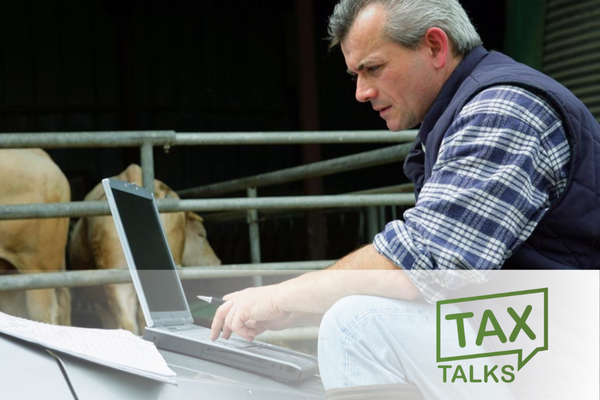October 27, 2025

When filing taxes for your farm business, two overarching premises dictate what income and expense are to be reported. On the income side, the Internal Revenue Service defines gross income as “all income from whatever source derived,” stipulating that all forms of income are to be reported unless a specific exclusion exists. For an expense to be deductible, it must be both ordinary and necessary. Ordinary means it is common and accepted in your industry, while necessary means it is appropriate and helpful for your business.
Farm Income
Schedule F of a tax return encompasses most of the ordinary and reoccurring revenues associated with the production of income within a farm business. While not an exhaustive list, the following is a summary of the types of income that might be reported on each income line of the Schedule F.
|
Schedule F Line Items |
Income examples |
|
Line 1a and 1b: Sales of purchased livestock and other resale items |
A beef farmer may buy young cattle and raise them on the farm to be sold later. The gross sale proceeds would be reported on Line 1a with the original cost of the youngstock subtracted on Line 1b. |
|
Line 2: Sales of livestock, produce, grains, and other products you raised |
Crop sales, other commodities not sold through a cooperative, calf sales (dairy farm), beef cattle sales |
|
Line 3a and 3b: Cooperative Distributions |
Income reported to you on Form 1099-PATR. Examples may include Farm Credit East patronage or milk sales to a cooperative. |
|
Line 4a and 4b: Agricultural Program Payments |
Income from USDA or FSA programs, generally reported on form 1099-G |
|
Line 5a and 5b: Commodity Credit Corporation Loans reported under election |
Farmers can make an election under IRC section 77 to include in income the proceeds of a loan obtained against their current year crop without having sold the actual commodity. |
|
Line 6a-d: Crop Insurance Proceeds and federal crop disaster payments |
Indemnity payments received from crop insurance programs, generally reported on Form 1099. Under certain circumstances, farmers can elect to defer the tax on these monies to the next tax year (Lines 6c and 6d). |
|
Line 7: Custom hire (machine work) income |
Income from providing a farm related service to other farmers: manure drag lining, custom planting or harvesting |
|
Line 8: Other Income |
Grants, federal and state fuel tax credits, rebates and refunds |
Form 4797
Form 4797 is used to report revenue from the sale of assets that when used on the farm generate income reported on the Schedule F but receive special tax treatment when disposed. The following is a summary of types of transactions that would be reported in each part of Form 4797.
|
Part I: Sales or Exchanges of Property Used in a Trade or Business – Most Property Held More than 1 Year |
Sales reported here will receive preferential Long Term Capital Gains tax rates. Common examples include the sale of farmland, and the sale of animals held for over 24 months that were used for dairy, breeding, sport or draft purposes. |
|
Part II: Ordinary Gains and Losses |
This section encompasses sales of assets that were held for less than 1 year (less than 2 years for livestock) that otherwise would have been reported in Part I or Part III if the holding period was met, or transaction resulted in a gain. Common examples include the sale of dairy heifers under 24 months, or sales of farm equipment that result in a loss. |
|
Part III: Gain From Disposition of Property Under Sections 1245, 1250, etc. |
The sale of any farm equipment or livestock that was previously depreciated, and results in a gain, will be reported in this section. The sales price is compared to the adjusted tax basis (original cost – depreciation taken) to compute the gain. To the extent of the gain, previous depreciation deductions are required to be recaptured as ordinary income before capital gains treatment is allowed. |
Farm Expenses
To the extent expenses meet the ordinary and necessary standard, most costs of operating a farm business will be deductible on the Schedule F. Any expenses that have a mix of business and personal nature should be reviewed and allocated appropriately with only the business portion being deducted. With all expenses, proper documentation and substantiation of the expense should be retained to support both the amount and business purpose.
Just like with income, there are certain ordinary and necessary business expenses incurred by a farm operation that will be deducted on Form 4797 rather than Schedule F. Consider “expense of sale” expenditures like a realtor commission, auction commissions or any other expense that is only incurred because of the sale of an asset. Those expenses of sale would be added to the basis of the assets to reduce the gain rather than deducted on Schedule F against normal operating income. A good rule of thumb is that the expenses incurred to generate the income should be reported on the same form as the income.
Accurate and detailed recordkeeping is the first step to proper tax categorization of farm income and expense items. Properly capturing the full income and expense of an operation will drive the “bottom line” or taxable income. Furthermore, the proper characterization of the income and expense will determine the tax treatment of the net income (i.e. ordinary vs capital gains, self-employment or non-self-employment), thereby affecting how much tax is owed.




